Redstone components are the blocks used to build redstone circuits. Redstone components include power components (such as redstone torches, buttons, and pressure plates), transmission components (such as redstone dust and redstone repeaters), and mechanism components (such as pistons, doors, and redstone lamps).
This article assumes familiarity with the basics of redstone structures. This article also limits its discussion of each component to its role in redstone structures; for full details about a component, see the main article for the block.
Power components
Power components create redstone signals, either permanently or in response to player, mob, and environmental activity.
Block of redstone
A block of redstone provides constant power. It can be moved by pistons.
- Activation
- A block of redstone is always ON.
- Effect
- A block of redstone powers adjacent mechanism components (including those above or below) and adjacent redstone dust. It also powers adjacent redstone comparators or redstone repeaters facing away from it.
- A block of redstone does not power adjacent opaque blocks.
Button
A button is used to generate a pulse. A button may be of two types: wooden or stone.
- Placement
- A button can be attached to any part of most opaque blocks. If the attachment block is removed, the button drops into the item form.
- Activation
- A player can activate a button by right-clicking it. A stone button stays ON for 10 ticks (1 second), while a wooden button stays ON for 15 ticks (1.5 seconds). A wooden button can also be turned ON by an arrow that has been shot at it. In such a case, the button remains ON until the arrow despawns (after one minute) or is taken.
- Effect
- While activated, a button and its attachment block both power adjacent redstone dust (including beneath the button, and beneath and on top of the block), and all adjacent redstone comparators or redstone repeaters facing away from it. They also activate all adjacent mechanism components (including those above or below).
Calibrated sculk sensor
Chiseled bookshelf
Daylight detector
A daylight detector can be used to detect the time of the Minecraft day.
- Activation
- A daylight detector, if exposed to the sky ("sl" greater than 0), remains activated while the sun is in in the sky. A daylight detector blocked from the sky ("sl" equals 0) remains activated while the moon is in the sky.
- Effect
- While activated, a daylight detector powers adjacent redstone dust (including beneath it), and all adjacent redstone comparators or redstone repeaters facing away from it, at a power level proportionate to the height of the sun or moon in the sky. It also activates all adjacent mechanism components (including those above or below).
- A daylight detector does not power adjacent opaque blocks.
Detector rail
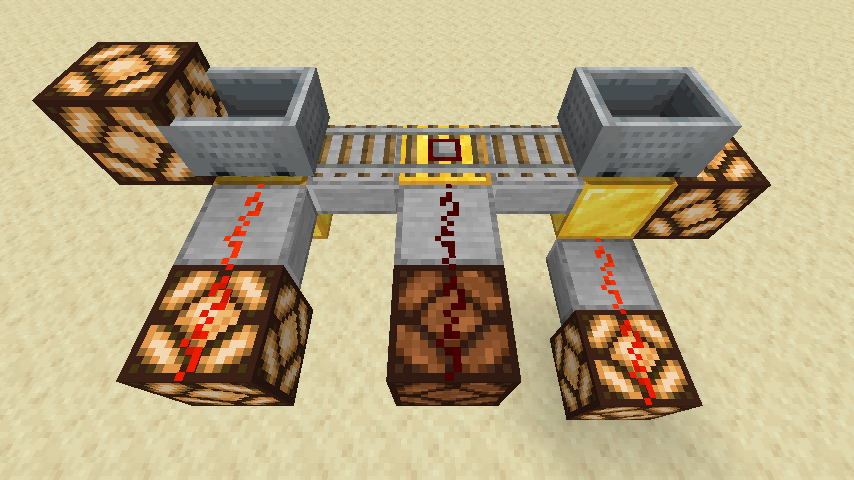
A detector rail is used to detect the passage of a minecart.
- Placement
- A detector rail can be attached to the top of any opaque block, or to the top of an upside-down slab or upside-down stairs. If the attachment block is removed, the detector rail drops as an item.
- When placed, a detector rail lines up with adjacent rails, powered rails, and other detector rails, as well as adjacent rails one block above it. If there are two adjacent rails not on opposite sides, or three or more adjacent rails, the detector rail lines up in the east-west direction. If there are no adjacent rails, the detector rail lines up in the north-south direction. If there is an adjacent rail one block above, the detector rail slants to match it (when there is more than one adjacent rail to slant toward, the order of preference is: west, east, south, and north). Other configurations can be created by placing and removing various rail.
- Activation
- A detector rail turns ON when a minecart passes over it, and turns OFF when it leaves.
- Effect
- While activated, a detector rail and its attachment block (unless attached to a slab or stairs) both power adjacent redstone dust (including beneath the block), and all adjacent redstone comparators or redstone repeaters facing away. They also activate all adjacent mechanism components (including those above or below).
Jukebox
A jukebox with a music disc playing emits a redstone signal of strength 15.
Lectern
A lectern is a block that can hold written books so they can be read.
- Placement
- Lecterns can face north, south, east or west, facing toward the player when placed. This has a redstone effect judging on the book page.
- Activation
- When the page of the book it is holding is turned, the lectern emits a redstone pulse that is one game tick long (0.5 redstone ticks).
Lever

A lever is used to switch circuits on or off, or to permanently power a block.
- Placement
- A lever can be attached to any part of most opaque blocks, or to the top of an upside-down slab or upside-down stairs. If the attachment block is removed, the lever drops as an item.
- Activation
- A player can turn a lever ON or OFF by right-clicking it.
- Effect
- While activated, a lever and its attachment block (unless attached to a slab or stairs) both power adjacent redstone dust (including beneath the lever, or beneath or on top of the block), and all adjacent mechanism components (including those above or below it). They also activate all adjacent redstone comparators or redstone repeaters facing away.
Lightning rod
A lightning rod emits a redstone signal strength of 15 when struck by lightning.
Observer
An observer can be used to detect block changes.
- Placement
- An observer can be placed anywhere and can face in any direction, including up or down. When placed, the observer's side that detects block changes (its face) faces away from the player and the side that produces a pulse faces the player.
- Activation
- An observer turns ON when the block in front of its face changes state (for example, a block being placed or mined, water changing to ice, a repeater having its delay changed by a player, etc.). The observer stays ON for 2 redstone ticks (4 game ticks, or 0.2 seconds barring lag) and then turns OFF automatically.
- An observer also turns ON for 1 game ticks after it is moved by a piston.
- Effect
- When activated, an observer produces a 1tick pulse from the side opposite its face.
Pressure plate
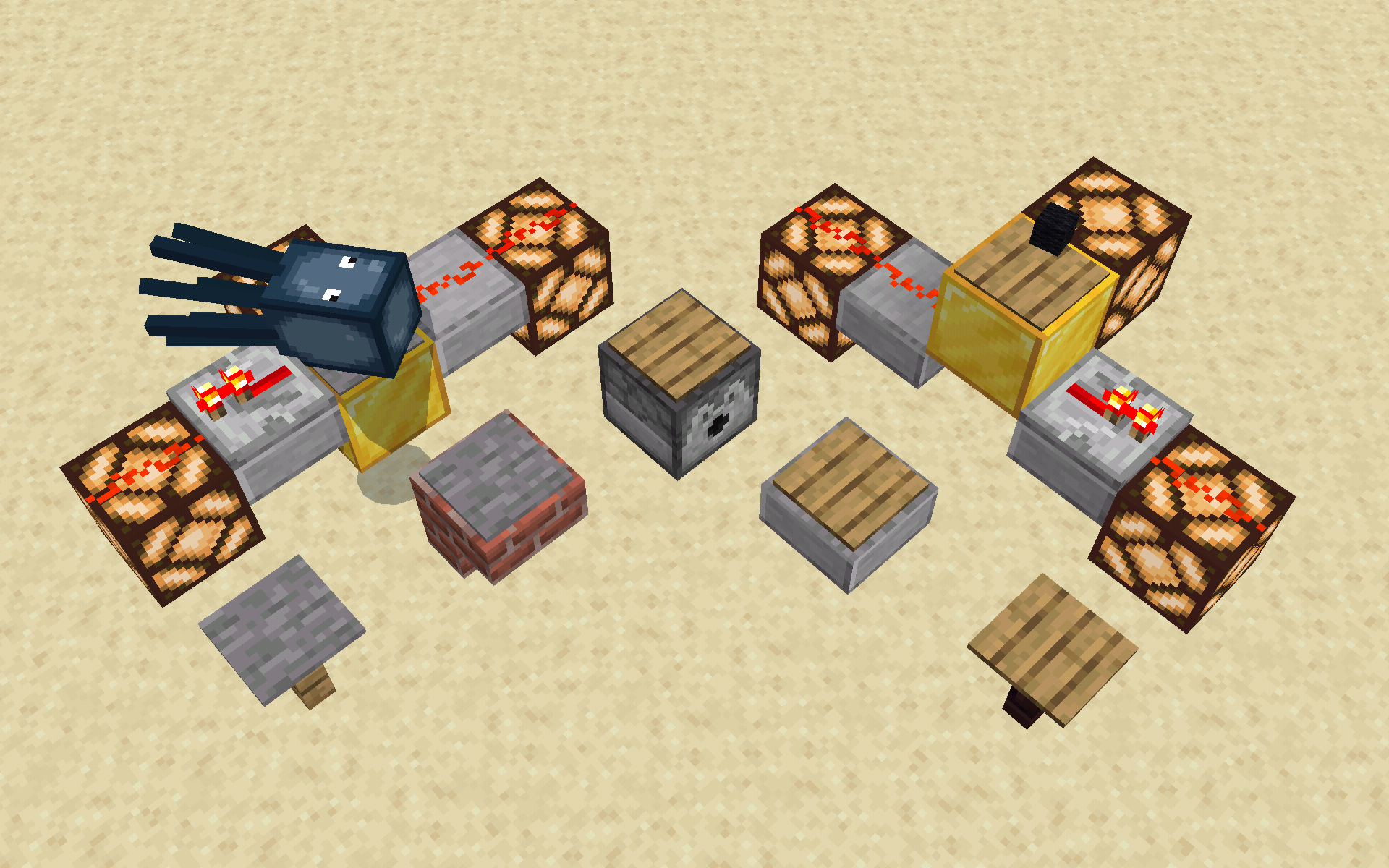
A pressure plate can be used to detect mobs, items, and other entities. A pressure plate may be of two types: wooden or stone.
- Placement
- A pressure plate can be attached to the top of any opaque block, or to the top of a fence, nether brick fence, an upside-down slab or upside-down stairs. If the attachment block is removed, the pressure plate drops as an item.
- Activation
- A pressure plate turns ON when an entity (mob, item, etc.) crosses or falls on it, and turns OFF when the entity leaves or is removed. A wooden pressure plate may be turned ON also by falling items and arrow shots. A wooden pressure plate that is activated in this way turns OFF when the object is picked up or despawns (after one minute for a shot arrow, or up to five minutes for an item).
- Effect
- While activated, a pressure plate and its attachment block (unless attached to a fence, nether brick fence, slab, or stairs) both power adjacent redstone dust (including beneath the block), and all adjacent mechanism components (including those above or below). They also activate all adjacent redstone comparators or redstone repeaters facing away.
- Considerations
- A pressure plate is not solid (it cannot be used as a wall or platform). Usually a block under a pressure plate provides solid ground (for mobs to walk across, items to fall on, etc.), but when a pressure plate is placed on a block with a small collision mask, like a fence or nether brick fence, it is possible for entities to move through the pressure plate and still activate it. Thus, a pressure plate on a fence can be used to detect entities without stopping them (more compactly than a tripwire circuit).
Redstone torch
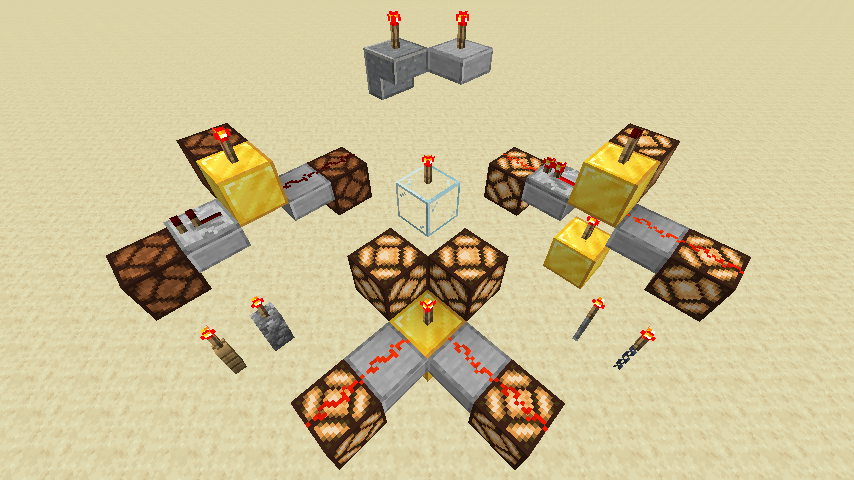
A redstone torch powers circuits (horizontally and vertically), and can invert signals.
- Placement
- A redstone torch can be attached to any surface (except the bottom) of any opaque block, or to the top of: a cobblestone wall, a fence, glass, nether brick fence, an upside-down slab or upside-down stairs. If the attachment block is removed, the redstone torch drops as an item.
- Activation
- A redstone torch turns OFF when its attachment block receives power from another source and turns back on when the block loses power.
- Effect
- While activated, a redstone torch and any opaque block above it both power adjacent redstone dust (including beneath the redstone torch, or on top of the block), and all adjacent mechanism components (including those above or below it). They also activate all adjacent redstone comparators or redstone repeaters facing away from it.
- A redstone torch does not affect the block it is attached to (even if it is a mechanism component).
- Considerations
- A redstone torch can burn out (stop turning on) when it is forced to flicker on and off too quickly (by powering and de-powering its attachment block). After burning out, a redstone torch re-lights when it receives a redstone update, or randomly after a short time.
- One way to cause a burnout is with a short-circuit – using a torch to turn itself off, which then allows the torch to turn back on, etc. For example, placing redstone dust on top of a block with a redstone torch on its side, then putting another block above the torch, causes the torch to power the top block, which activates the dust, which powers the first block, turning the torch off – this feedback loop causes the redstone torch to flicker and burn out. When putting a torch underneath a block, make sure that the block isn't adjacent to redstone dust or the torch can burn out.
Sculk sensor
A sculk sensor emits a redstone signal when it detects a vibration
_target
A _target emits a redstone signal when hit by a projectile (including arrows, tridents, eggs, snowballs, splash potions, fire charges fired from dispensers, and lingering potions, but excluding ender pearls and eyes of ender).
- Activation
- Arrows and Tridents emit a pulse of 10 redstone ticks, while other projectiles emit a pulse of 4 redstone ticks. The closer the projectile is to the center of the block, the stronger the signal it produces is, from 1 (at the edge) to 15 (in the center).
Trapped chest
A trapped chest can be used to detect when a player tries to take from it.
- Activation
- A trapped chest is turned ON when a player accesses its contents.
- Effect
- While activated, a trapped chest and any opaque block beneath it both power adjacent redstone dust (including beneath the block), and all adjacent mechanism components (including those above or below it). They also activate all adjacent redstone comparators or redstone repeaters facing away from it, at a power level equal to the number of players simultaneously accessing its contents (maximum 15).
Tripwire hook
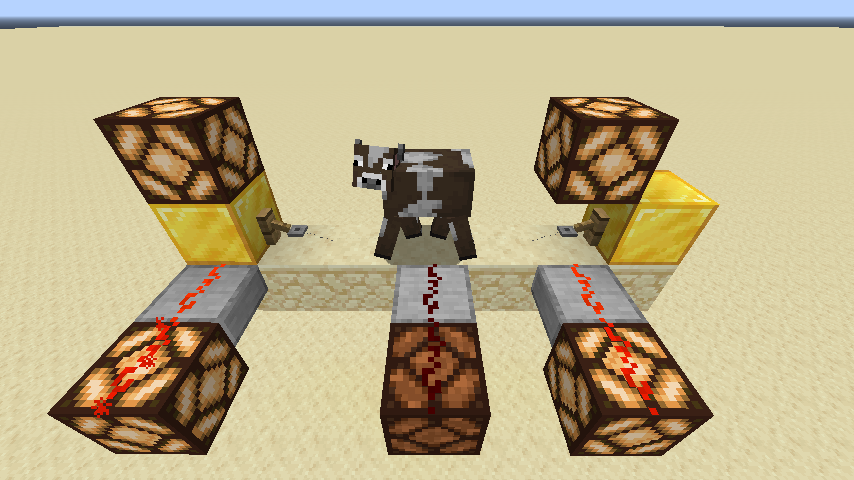
A tripwire hook is used to detect mobs, items, and other entities over a large area.
- Placement
- A tripwire hook can be attached to the side of most opaque blocks. If the attachment block is removed, the tripwire hook drops as an item.
- In order to function correctly, a tripwire hook must be part of a tripwire circuit: two opaque blocks attached to tripwire hooks, at the ends of a tripwire line (one or more blocks of tripwire).
- To place tripwire, right-click on an adjacent block with a string. Tripwire can be placed on the ground or in the air, and forms a valid tripwire line only if all the tripwire is of the same type. Tripwire is considered on the ground if placed on any opaque block, or on a block of redstone, a hopper, an upside-down slab, or an upside-down stairs. Tripwire is considered in the air if placed on or above any other block. Tripwire on the ground has a short hitbox (1/8 block tall), while tripwire in the air has a taller hitbox (1/2 block tall).
- If the attachment block under ground tripwire is removed, the tripwire drops as string.
- A tripwire circuit is properly placed when the tripwire hooks are fully extended and the tripwire line runs continuously between the tripwire hooks. Tripwire lines from separate tripwire circuits can be placed next to each other (in parallel), above each other, and can even intersect each other.
- Activation
- A tripwire hook turns ON when an entity (mob, item, etc.) crosses or falls on the hook's tripwire line (but not the tripwire hook), and turns OFF when all entities leave or are removed from the tripwire line. A tripwire hook also turns ON for 5 ticks (1/2 second) when any of its tripwires are destroyed, except when using shears to cut the tripwire. Breaking the tripwire hook, or its attachment block, does not generate a pulse.
- Effect
- While activated, a tripwire hook and its attachment block both power any adjacent redstone dust (including below the tripwire hook, or beneath or above the block), and all adjacent mechanism components (including those above or below it). They also activate all adjacent redstone comparators or redstone repeaters facing away from it.
- Tripwire itself provides no power.
Transmission components
Transmission components propagate signals and pulses from power components to mechanism components. Complex effects can also be produced by allowing a signal to affect itself or its circuit.
Redstone dust
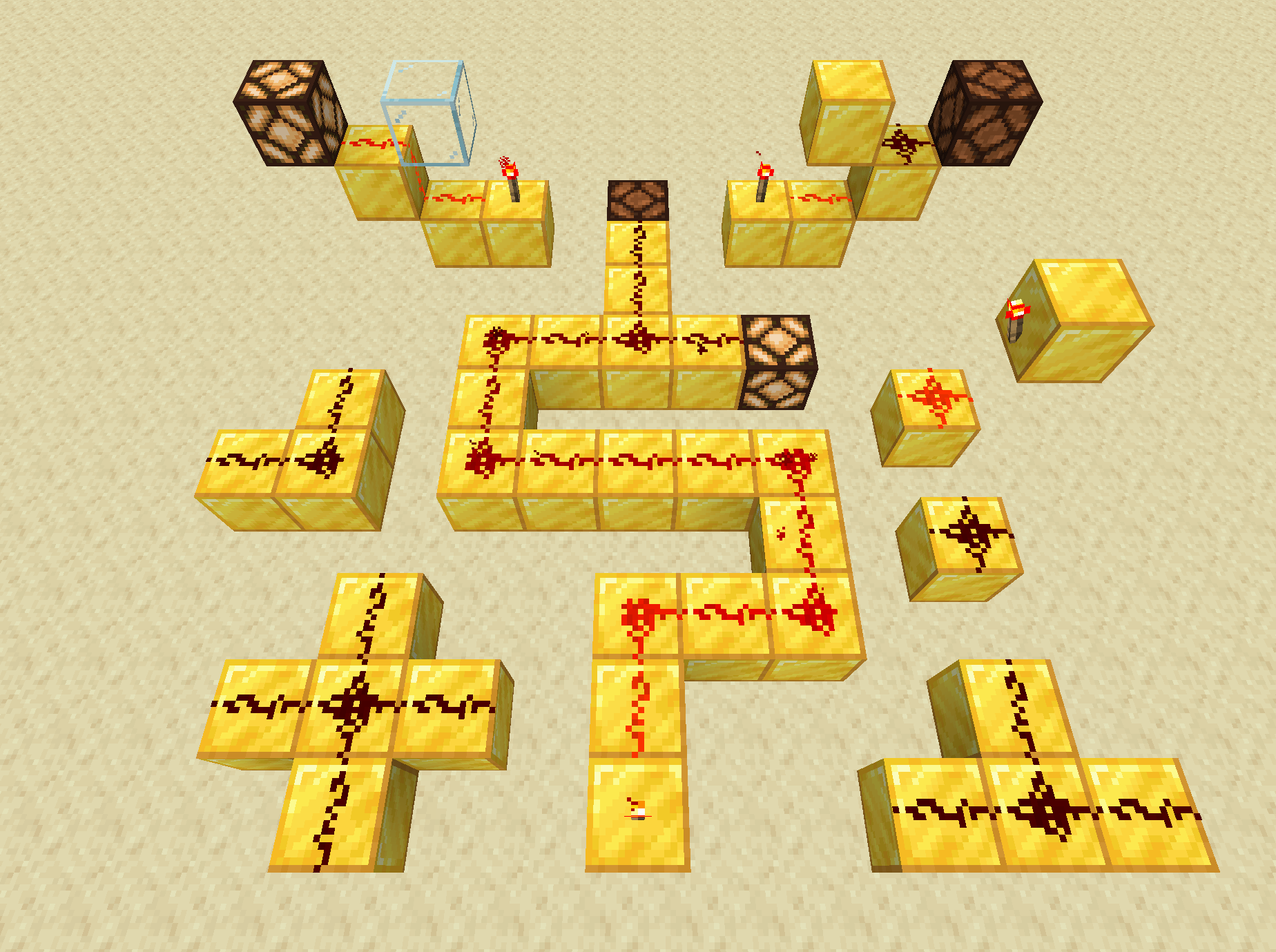
Redstone dust transmits power.
- Placement
- Redstone dust is placed by right-clicking with redstone dust. Redstone dust can be attached to the top of any opaque block, or to the top of glowstone, an upside-down slab or upside-down stairs. If the attachment block is removed, the redstone dust drops as an item.
- When placed, redstone dust configures itself to point toward adjacent redstone dust (at the same level or one level up or down), correctly-facing redstone repeaters and redstone comparators, and power components. If there is only one such neighbor, redstone dust forms a line pointing toward and away from that one neighbor (which can cause it to point toward blocks it wouldn't normally point toward). If there are multiple such neighbors, redstone dust forms either a line, an "L", a "T", or a "+". If there are no such neighbors, redstone dust forms a large directionless dot. Redstone dust does not automatically configure itself to point toward adjacent mechanism components, it must be arranged to do so.
- When two redstone dust trails are placed vertically diagonally (one block over and one up, or one over and one down), the lower dust trail appears to crawl up the side of the higher block to join the other dust. This linking can be cut by an opaque block above the lower trail, which prevents the two trails from connecting. If the higher trail is on an upside-down slab or upside-down stairs, the higher trail configures itself to point toward the lower trail (and other adjacent dust), but the lower trail (although visually) does not configure itself to point toward the higher trail (including not appearing to crawl up the side of the slab or stairs).
- The directions in which redstone dust configures itself can affect whether it powers adjacent opaque blocks and mechanisms.
- Activation
- Redstone dust can be turned ON by any adjacent power component, redstone repeater pointing at it, or strongly-powered opaque block. Redstone dust can also be turned ON by other adjacent powered redstone dust, but the power decreases with distance from a strongly-powered block. Redstone dust transmits power up to 15 blocks away.
- Redstone dust can transmit power diagonally upward to dust on an upside-down slab or upside-down stairs, but not diagonally downward from an upside-down slab or upside-down stairs.
- Effect
- Powered redstone dust turns ON any mechanism component it is configured to point at. It powers, weakly, an opaque block that it lies on or points to.
Redstone repeater
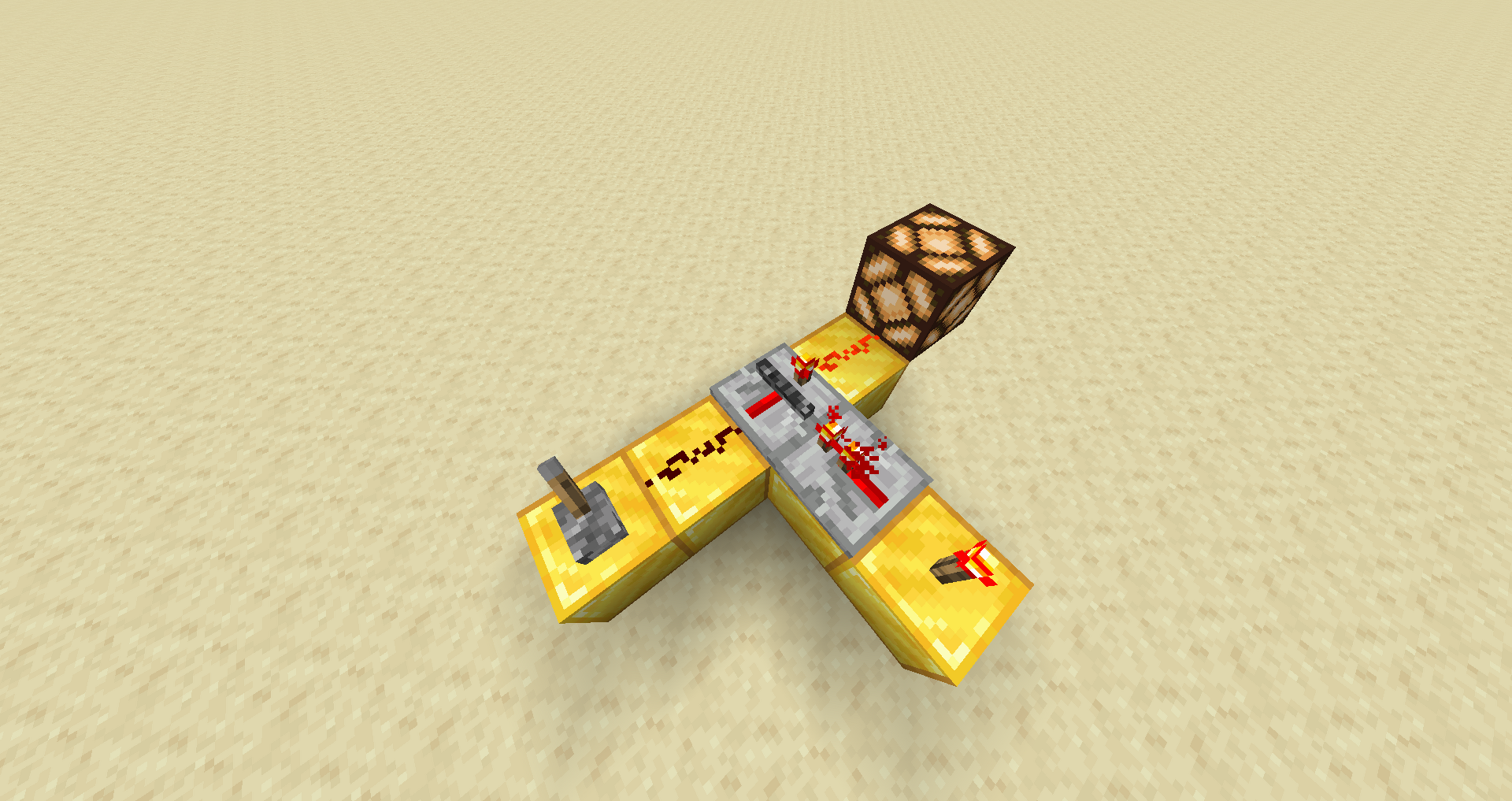
A redstone repeater is used to transmit power, strengthen redstone dust signals weakened by distance, delay a signal, and redirect a signal.
- Placement
- A redstone repeater can be attached to the top of any opaque block, or to the top of an upside-down slab or upside-down stairs. If the attachment block is removed, the redstone repeater drops as an item.
- A redstone repeater is marked with an arrow pointing toward its front. The repeater reacts only to signals from the block behind it and propagates signals only to the block in front of it (in the direction of the arrow). It also has an adjustable delay that can be set from 1 to 4 ticks by right-clicking it.
- Activation
- A redstone repeater is turned ON by any powered component at its back and is unaffected by the powered state of any block beside, above, below, or in front of it (but see below about locking a repeater).
- Effect
- A powered redstone repeater turns ON redstone dust or a mechanism component in front of it, or strongly powers an opaque block in front of it. It has no effect on the blocks under, above, beside, or behind it.
- A redstone repeater not only strengthens it for further transmission, it also delays it by 1 to 4 ticks. A redstone repeater also increases the duration of any pulse shorter than its delay to match the duration of its delay.
- A redstone repeater can be locked by powering it from the side with another redstone repeater or with a redstone comparator. A locked repeater does not change its output state until unlocked, even if its input changes. A locked repeater displays its locked status with a bedrock bar.
Redstone comparator
A redstone comparator is used to compare or subtract two signals, or to measure how full a container is.
- Placement
- A redstone comparator can be attached to the top of any opaque block, or to the top of an upside-down slab or upside-down stairs. If the attachment block is removed, the redstone comparator drops as an item.
- A redstone comparator is marked with an arrow that point toward its front. The comparator takes a signal from its back as its input, and outputs a signal to the block in front of it, but can also be affected by signals from its sides (see below).
| Power Level |
Containers and Slots | |||||||
|---|---|---|---|---|---|---|---|---|
|
|
||||||||
| 4 | 27 | 54 | 9 | 3 | 5 | — | ||
| 0 | 0 | 0 | 0 | 0 | 0 | 0 | — | |
| 1 | 1i | 1i | 1i | 1i | 1i | 1i | "13" | |
| 2 | 19i | 1s 60i |
3s 55i |
42i | 14i | 23i | "cat" | |
| 3 | 37i | 3s 55i |
7s 46i |
1s 19i |
28i | 46i | "blocks" | |
| 4 | 55i | 5s 51i |
11s 37i |
1s 60i |
42i | 1s 5i |
"chirp" | |
| 5 | 1s 10i |
7s 46i |
15s 28i |
2s 37i |
55i | 1s 28i |
"far" | |
| 6 | 1s 28i |
9s 42i |
19s 19i |
3s 14i |
1s 5i |
1s 51i |
"mall" | |
| 7 | 1s 46i |
11s 37i |
23s 10i |
3s 55i |
1s 19i |
2s 10i |
"mellohi" | |
| 8 | 2s | 13s 32i |
27s | 4s 32i |
1s 32i |
2s 32i |
"stal" | |
| 9 | 2s 19i |
15s 28i |
30s 55i |
5s 10i |
1s 46i |
2s 55i |
"strad" | |
| 10 | 2s 37i |
17s 23i |
34s 46i |
5s 51i |
1s 60i |
3s 14i |
"ward" | |
| 11 | 2s 55i |
19s 19i |
38s 37i |
6s 28i |
2s 10i |
3s 37i |
"11" | |
| 12 | 3s 10i |
21s 14i |
42s 28i |
7s 5i |
2s 23i |
3s 60i |
"wait" | |
| 13 | 3s 28i |
23s 10i |
46s 19i |
7s 46i |
2s 37i |
4s 19i |
"pigstep" | |
| 14 | 3s 46i |
25s 5i |
50s 10i |
8s 23i |
2s 51i |
4s 42i |
"otherside" "Relic" | |
| 15 | 4s | 27s | 54s | 9s | 3s | 5s | "5" | |
- A redstone comparator has two modes. Right-clicking it toggles between comparison mode (front torch down/off) and subtraction mode (front torch up/on).
- Activation
- A redstone comparator is turned ON by a power source at its input or a power source separated by one opaque block from its input. Power sources include any powered component, a non-empty container, a container minecart on a detector rail, a command block that has run its last command successfully, a cauldron containing water, an end portal frame with an eye of ender, or a jukebox with a record. Either at its back or separated from its back by an opaque block. It is not affected by blocks beneath it or above it, but its signal strength can be modified by signals from its sides (see below).
- Effect
- A powered redstone comparator turns ON redstone dust, a properly-facing redstone comparator or redstone repeater, or a mechanism component in front of it; or strongly powers an opaque block in front of it – all at the same power level as its input signal (unless modified by a side signal, see below). It has no effect on blocks in other adjacent positions (including the block beneath it).
- The output of a redstone comparator can be affected by a signal provided from its side by a transmission component (redstone dust, redstone repeater, or another redstone comparator only):
- In comparison mode, a redstone comparator propagates its input signal only if the input signal is greater than the side signal, and outputs no signal if not.
- In subtraction mode, a redstone comparator outputs a power level equal to the difference of the power level of the input signal minus the power level of the side signal.
- A redstone comparator that is activated by a container outputs a power level in proportion to how full the container is (rounded up, so a single item in a container produces a power level of at least 1). A container's fullness is measured by stacks: for example, a single shovel (a non-stackable item), 16 signs, or 64 sticks are all considered to be equivalent, full stacks.
- The Comparator Output Table (right) shows the minimum stacks ("s") plus items ("i") required to produce a specific power level from a container. For example, to get power level 5 from a hopper, put 1 stack plus 28 items in the hopper. Divide items by 4 and round up for items with a stack maximum of 16. The values for the chest, dispenser, furnace and hopper apply to minecarts with those components as well (when on a detector rail).
- Some blocks (such as crafting tables, enchantment tables, etc.) can hold items temporarily while the player uses the block's interface – the items are returned to the player if the player exits the interface with items still inside. Other blocks (such as beacons) only consume items. Putting items in these blocks never activates a redstone comparator.
Mechanism components
Mechanism components are blocks that react to redstone power by affecting the environment – by moving themselves or other entities, by producing light, sound, or explosions, etc.
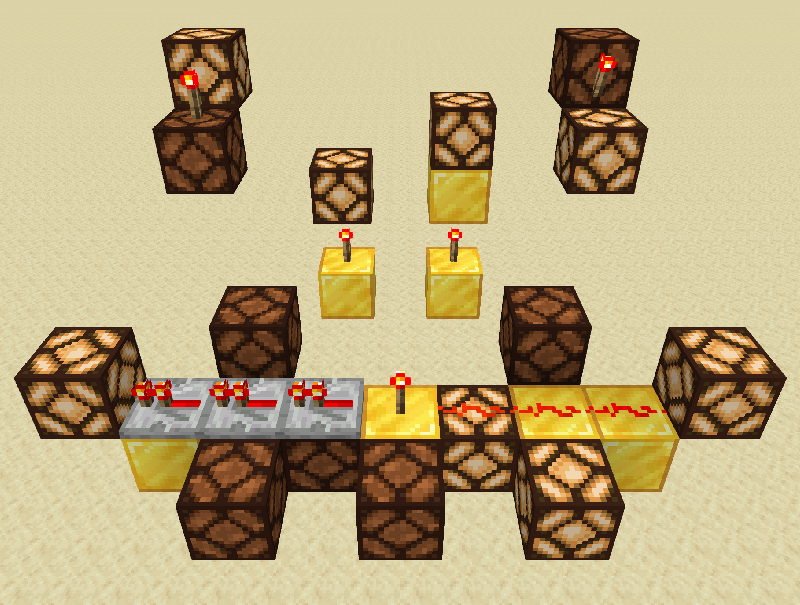
- Activation
- Mechanism components are turned on by:
- an adjacent active power component (Exceptions: a redstone torch does not activate a mechanism component it is attached to, and a piston is activated only by a power component directly in front of it if the component is connected to it.)
- an adjacent powered opaque block (strongly-powered or weakly-powered)
- a powered redstone repeater or redstone comparator facing the mechanism component
- powered redstone dust configured to point toward the mechanism component (or on top of it, for opaque mechanism components); a mechanism component is not turned ON by adjacent powered redstone dust that is not configured to point toward it.
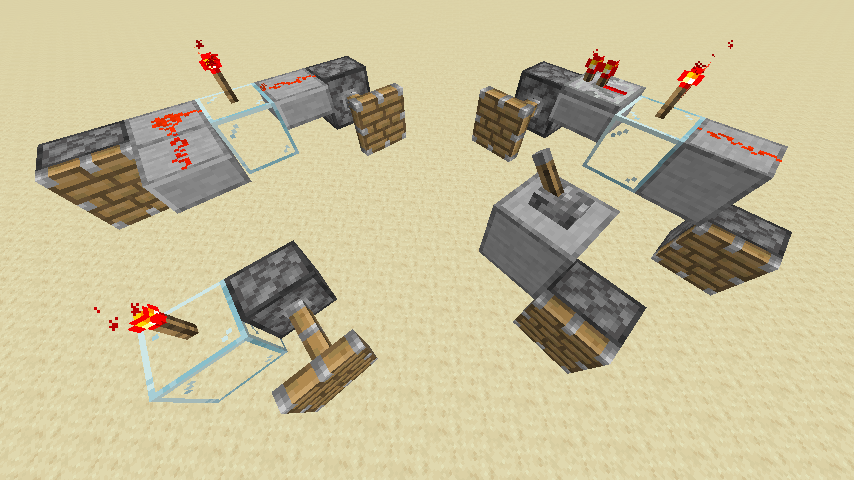
- Quasi-Connectivity
- In addition to the methods above, pistons, dispensers, and droppers can also be turned ON if a block above it receives a block update (including a redstone update within two blocks of the component) and is powered by any of the above means, even without a mechanism component (e.g.; even if the block above the component is air or a transparent block). This rule is often simplified to say that the components can be powered by blocks diagonally above or two blocks above, however other methods of activation by connectivity exist (see image to the right). This method of activation is also known as "connectivity", "piston connectivity" (as it originated with pistons), or simply "indirect power".
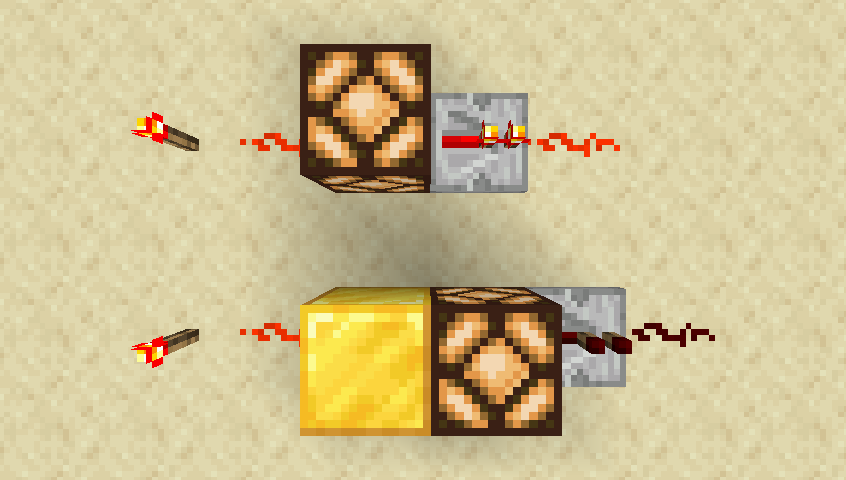
- Activated vs. Powered
- For opaque mechanism components (command blocks, droppers, dispensers, note blocks and redstone lamps), it's important to make a distinction between a mechanism component being activated (so that it performs an action) and being powered (so that a redstone signal could be drawn from it by a transmission component). Any method of powering a mechanism component (such as a redstone torch underneath it) also activates it, but some activation methods (such as a redstone torch next to or above a mechanism component) does not actually power the component (following the usual rules for power components).
Activator rail
An activator rail is used to activate a minecart.
- Placement
- An activator rail can be attached to the top of any opaque block, or to the top of an upside-down slab or upside-down stairs. If the attachment block is removed, the activator rail drops as an item.
- When placed, an activator rail configures itself to line up with adjacent rails, activator rails, powered rails, and detector rails, as well as such adjacent rails one block above. If there are two such adjacent rails not on opposite sides, or three or more such adjacent rails, an activator rail lines up in the east-west direction. If there are no such adjacent rails, an activator rail lines up in the north-south direction. An activator rail slopes upward to match with a rail above it (when there is more than one such rail, the order of preference is: west, east, south, and north). Other configurations can be created by placing and removing various rails.
- Activation
- In addition to the methods above, an activator rail can also be activated by an activator rail adjacent to it that is activated. Activator rail can transmit activation up to 9 rails (the first originally-activated activator rail, and up to eight additional activator rails). Activation transmitted in this way can power only activator rails.
- Effect
- An activator rail affects certain minecarts passing over it. The effects vary with the type of minecart activated:
- A minecart with command block executes its command every 2 redstone ticks (5 times per second).
- A minecart with hopper is deactivated by an activated activator rail (it stops sucking up items in its path, or transferring items to containers as it passes them), and re-activated by an unactivated activator rail.
- A minecart with TNT is ignited by an active activator rail.
- Regular minecarts with an entity riding it (mob or player) eject that entity if the activator rail is active.
- Other minecarts are not affected by an activator rail.
Bell
Bells can be rung using a redstone signal.
Dispenser
A dispenser is used to automatically affect the environment by throwing items.
- Activation
- See Quasi-Connectivity above.
- Effect
- When activated, a dispenser ejects one item. If multiple slots are occupied by items, a random item is ejected.
- The effects of being activated vary with ejected item:
Dispenser Behavior Item Effect ArmorElytraHeads Equips on a player within a one-block distance (any armor, made from any material) ArrowBottle o' Enchanting
Egg
Fire Charge
Snowball
Splash PotionFired in the direction the dispenser is facing, as if a player had used the item him or herself Boat Placed as entity (i.e., a right-clickable vehicle) onto the block in front of the dispenser, if it is water or air above water; otherwise dropped (see below) Firework Rocket Placed as entity (i.e., a flying firework) onto the block in front of the dispenser Bone Meal Increments the growth stage of carrots, cocoa pods, crops, melon stems, potatoes, pumpkin stems, and saplings in front of the dispenser; grows grass, dandelions, and roses, if a grass block is in front of the dispenser; grows a huge mushroom if facing a mushroom; otherwise remains unused Bucket Collects lava or water in front of the dispenser (replacing the empty bucket in the dispenser with a lava bucket or water bucket); otherwise dropped (see below) Flint and Steel Ignites the block the dispenser is facing; reduces the remaining durability of the used flint and steel Lava Bucket
Water BucketPlaces lava or water in the block in front of the dispenser (replacing the lava or water bucket in the dispenser with an empty bucket), if the block in front of the dispenser is one that the player could use a lava or water bucket on (e.g., air, flowers, grass, etc.); otherwise dropped (see below) Minecart
Minecart with Chest
Minecart with Command Block
Minecart with Furnace
Minecart with Hopper
Minecart with TNTPlaced as entity (i.e., a right-clickable vehicle) in the block in front of the dispenser, if the dispenser is in front of a type of rail; otherwise dropped (see below) TNT Ignites TNT on the block in front of the dispenser Shears Shears sheep within a one-block radius Glowstone If a respawn anchor is one block away, it fills the respawn anchor by 1 as if a player had right clicked with glowstone. If the respawn anchor is full, the dispenser does nothing Others Dropped—ejected toward the block in front of the dispenser, as if the player had used the Drop control (default Q)
- Considerations
- A dispenser is an opaque block, so powering it directly can activate adjacent mechanism components (including other dispensers) as well.
Door
A door is used to control or prevent the movement of mobs, items, boats, and other entities. A door may be of two types: a wooden door can be opened and closed by redstone power or by a player right-clicking on it, while an iron door can be operated only by redstone power.
- Placement
- A door can be attached to the top of most opaque blocks, or to the top of an upside-down slab or upside-down stairs. If the attachment block is removed, the door drops as an item.
- A door is placed on the edge of the block facing the player. By default the door's hinge is positioned on the left side, but another door or block can force the hinge to the right side.
- Effect
- While activated, a door re-positions to the other side of its hinge, allowing movement through its former position and denying movement through its current position. When activated, any entities on the door fall off.
- A door doesn't actually move (the way a piston arm or a pushed block moves), it simply disappears from one side and re-appears on another; therefore, it does not push entities as it opens.
Dragon Head
The dragon head opens and closes its mouth repeatedly like the ender dragon when placed and powered by redstone.
Dropper
A dropper is used to eject items or push them into containers (including other droppers).
- Placement
- A dropper can be placed so that its output faces in any direction.
- Activation
- See Quasi-Connectivity above.
- Effect
- When activated, a dropper ejects one item. If multiple slots are occupied by items, a random occupied slot is chosen for ejection.
- If the dropper is facing a container, the ejected item is transferred into the container. Otherwise, the item is ejected in the direction the dropper is facing, as if the player had used the Drop control.
- Considerations
- A dropper is an opaque block, so powering it directly can cause adjacent mechanism components (including other droppers) to activate as well.
Fence gate
A fence gate is used to control or prevent the movement of mobs, items, boats, and other entities.
- Placement
- A fence gate can be placed on the top of most blocks. Once placed, the block beneath it may be removed without popping the fence gate.
- Effect
- While activated, a fence gate re-positions its two gates to either side, allowing movement through it. When activated, any entities on the fence gate falls down.
- A fence gate doesn't actually move (the way a piston arm or a pushed block moves), it simply disappears from one state and re-appears in another, so it does not push entities as it opens.
- Unlike a door or trapdoor, while active, a fence gate is completely non-solid (lacks a collision mask) to all entities.
Hopper
A hopper is used to move items to and from containers (including other hoppers).
- Placement
- A hopper can be placed so that its output faces in any direction except up.
- Effect
- While not activated, a hopper pulls items from a container above it (or item entities in the space above it) into its own slots and pushes items from its own slots into a container it is facing. Both types of transfers occur every 4 redstone ticks (0.4 seconds), and pushes are processed before pulls. A hopper always pulls items into the leftmost available slot, and pushes items from leftmost slots before rightmost slots (it does not start pushing items from the second slot before the first is empty, from the third slot before the second is empty, etc.).
- While activated, a hopper does not pull items from above or push them out, but may receive items from other mechanism components such as droppers, and may have its items removed by another hopper beneath it.
Note block
A note block is used to produce a player-chosen sound.
- Placement
- After being placed, a note block's pitch can be adjusted over a two-octave range by right-clicking the note block, and its timbre can be adjusted by placing different blocks beneath it.
- Effect
- When activated, a note block produces a sound and send out block updates to all adjacent blocks. A note block must have air above it to activate.
- Considerations
- A note block is an opaque block, so powering it directly can cause adjacent mechanism components (including other note blocks) to activate as well.
Piston
A piston is used to move blocks or entities. A piston may be of two types: a regular piston only pushes blocks, while a sticky piston pushes and pulls blocks.
- Placement
- A piston has a stone base and a wooden head, and can be placed so the head faces in any direction (its front).
- Activation
See Quasi-Connectivity above.
- Effect
- When activated, a piston pushes the block in front of its arm, and up to 11 more blocks in front of that (up to 12 blocks total). When deactivated, a regular piston pulls its arm back (leaving an air block in front of the piston), while a sticky piston pulls back both its arm and one block (leaving an air block on the other side of the pulled block).
- A moving piston or block can also push an entity such as a mob or item.
- Some blocks (bedrock, obsidian, end portal frame, etc.) cannot be moved by a piston. Some blocks (flowers, leaves, torches, etc.) is destroyed, but may drop items (as if destroyed by the player). For full details of how pistons interact with other blocks, see Pushing Blocks.
- Slime blocks stick to blocks and make them move when adjacent blocks are moved. The 12 block limit still holds.
- Considerations
- When a sticky piston is activated by a pulse shorter than 1.5 ticks, it pushes the block in front of it, but fails to pull back the pushed block on the end of the pulse. If that sticky piston is activated again by any pulse, it can still pull back the block. Thus, a sticky piston running on fast pulses (for example, 1-tick pulses) pushes and pulls a block every other pulse.
- A piston is a transparent block, so powering it directly does not cause adjacent mechanism components (including other pistons) to activate (for exceptions see Quasi-Connectivity above).
Powered rail
A powered rail is used to propel a minecart.
- Placement
- A powered rail can be attached to the top of any opaque block, or to the top of an upside-down slab or upside-down stairs. If the attachment block is removed, the powered rail drops as an item.
- When placed, a powered rail configures itself to line up with adjacent rails, powered rails, and detector rails, as well as such adjacent rails one block up. If there are two such adjacent rails on non-opposite sides, or three or more such adjacent rails, a powered rail lines up in the east-west direction. If there are no such adjacent rails, a powered rail lines up in the north-south direction. If a rail it would line up with is one block up, a powered rail slants upward toward it (with multiple options to slant upward to, a powered rail prefers, in order: west, east, south, and north). Other configurations can be created by placing and removing various rail.
- Activation
- In addition to the methods above, a powered rail can also be activated by other adjacent activated powered rails. A powered rail can transmit activation up to 9 rails (the first originally-powered powered rail, and up to eight additional activated rails). Activation transmitted in this way cannot power any redstone components except powered rails, but the power change states can be detected by observers.
- Effect
- While activated, a powered rail boosts the speed of a minecart passing over it, or starts a minecart moving away from an adjacent solid block it is in contact with.
- While not activated, it acts as a brake, reducing the speed or even stopping a minecart passing over it.
Rail
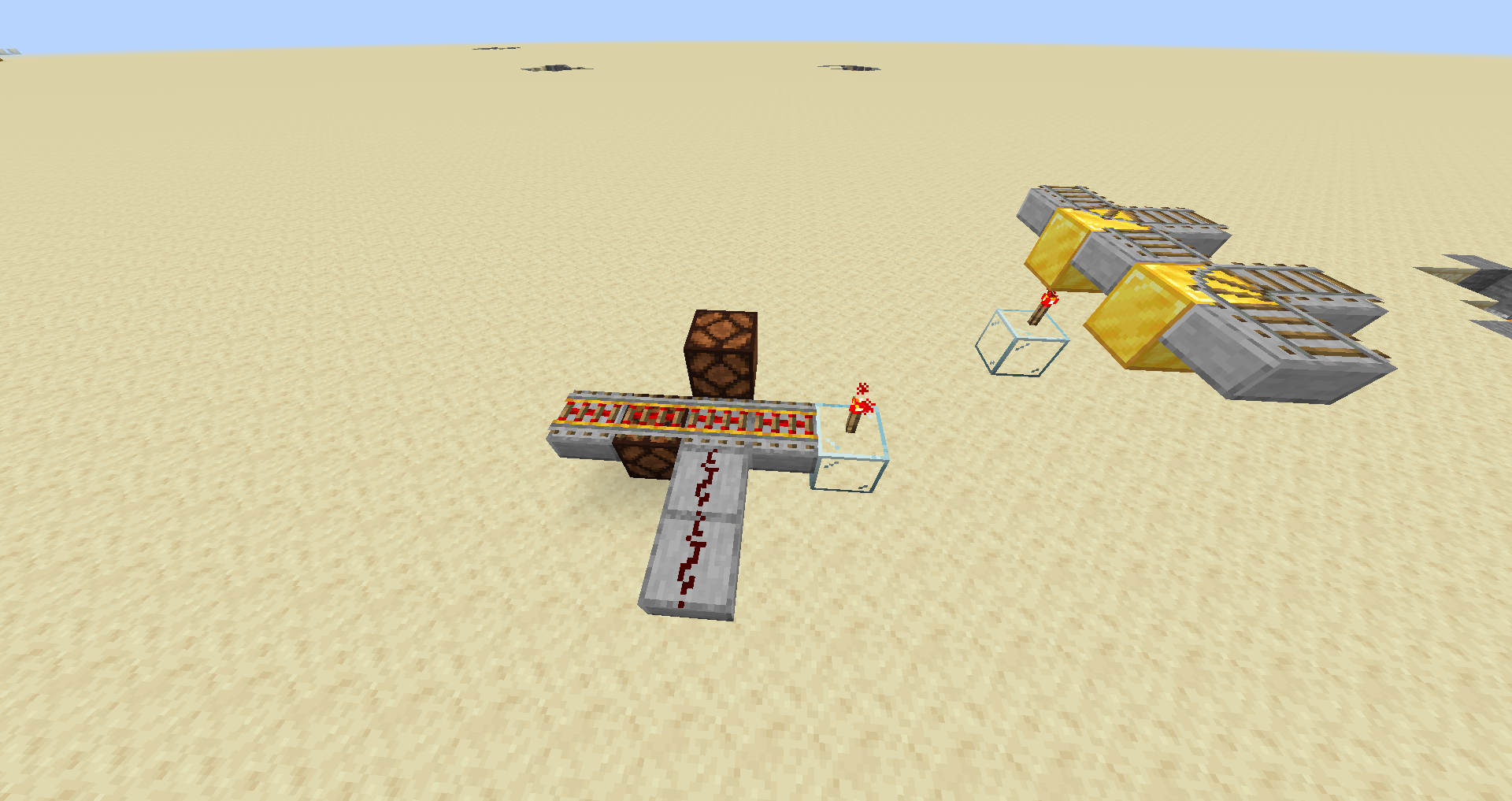
A rail is used to switch the track of a minecart.
- Placement
- A rail can be attached to the top of any opaque block, or to the top of an upside-down slab or upside-down stairs. If the attachment block is removed, the rail drops as an item.
- When placed, rail configures itself to line up with adjacent rails, powered rails, and detector rails, as well as such adjacent rails one block up. If there are two such adjacent rails on non-opposite sides, the rail curves from one to the other. If there are three or four such adjacent rails, the rail curves between two of them (when choosing which directions to curve between, a rail prefers south over north, and east over west). If there are no such adjacent rails, the rail lines up in the north-south direction. If a rail it would line up with is one block up, a rail slants upward toward it without curving (with multiple options to slant upward to, a rail prefers, in order: west, east, south, and north). Other configurations can be created by placing and removing various rails.
- Effect
- When activated, a rail in a "T" junction flips to curve the other way (activating a rail in another configuration has no effect).
Redstone lamp
A redstone lamp is used to provide light.
- Activation
- A redstone lamp activates normally, but takes 2 ticks to deactivate.
- Effect
- While activated, a redstone lamp has block light level 15 (so produces block light level 14 in all adjacent transparent spaces). An activated redstone lamp is transparent to sky light.
- Considerations
- A redstone lamp is an opaque block, so powering it directly can cause adjacent mechanism components (including other redstone lamps) to activate as well.
TNT
TNT is used to create an explosion.
- Activation
- In addition to the methods above, TNT can also be activated by fire and explosions, as well as flaming arrows.
- Effect
- When activated, TNT ignites and becomes primed TNT, an entity that can fall like sand or be pushed by pistons (but isn't moved by water). Primed TNT explodes 40 ticks (4 seconds) after being ignited by redstone power (10-30 ticks for TNT ignited by an explosion).
- Considerations
- A TNT is a transparent block, so powering it directly does not cause adjacent mechanism components (including TNTs) to activate.
Trapdoor
A trapdoor is used to control or prevent the movement of mobs, items, boats, and other entities. A trapdoor may be of two types: a wooden door can be opened and closed by redstone power or by a player right-clicking on it, while an iron door can be operated only by redstone power.
- Placement
- A trapdoor can be attached to the top, bottom, or the side of blocks. If the attachment block is removed, the trapdoor does not drop.
- Effect
- While activated, a trapdoor re-positions itself in a vertical state, allowing vertical movement through it. When activated, any entities on the trapdoor fall down.
- Similar to a door, a trapdoor doesn't actually move (the way a piston arm or a pushed block moves), it simply disappears from one state and re-appears in another, so it does not push entities as it opens.
Command block
A command block is used to execute a server command. Command blocks can be obtained only by placing it or giving it to the player with commands.
- Types
A command block have 3 types: impulse (execute a command once), chain (execute a command when triggered) and repeat (execute a command for 1 or more redstone ticks when powered)
- Placement
- After being placed, the player can set the command to be executed by right-clicking on the command block.
- Effect
- When activated, a command block executes its defined command once. To make a command block constantly execute its command, it must be run on a clock circuit or using a repeating command block.
- Like other mechanism components, an already-activated command block does not respond to other redstone signals. To make a command block execute its defined command more than once it must be deactivated and re-activated repetitively.
- Considerations
A command block is an opaque block, so powering it directly can activate adjacent mechanism components (including other command blocks) as well.
Structure block
A Structure Block is used to save and load structures. Structure blocks can be obtained only by placing it or giving it to the player with commands.
- Placement
- After being placed, the player can set the mode or the structure to save/load by right-clicking the structure block.
- Effect
- Redstone signals can be used to automate some of the structure block's functions.
- Like other mechanism components, an already-activated structure block does not respond to other redstone signals. To make a command block execute its defined command more than once it must be deactivated and re-activated repetitively.
Mobile components
Minecart
A minecart is used to transport a mob or player over rails.
- Behavior
- The player can move a minecart by pushing against it while outside the minecart (whether the minecart is on rails or not), or by pressing the Forward control key (by default, W) while inside the minecart (only while the minecart is on rails). A minecart resting on powered rails configured to point at an adjacent opaque block is propelled away from the opaque block when the powered rails are activated. A minecart traveling over activated powered rails gets a speed boost. When a minecart passes over an activated activator rails, the entity inside it is ejected out.
Minecart with chest
A minecart with chest (a.k.a. chest minecart, storage minecart) is used to store and transport items over rails.
- Behavior
- A minecart with chest accepts items from a hopper and allows a hopper underneath it to pull items from it.
Minecart with command block
A minecart with command block (a.k.a. command minecart, command block minecart) is used to execute commands.
- Behavior
- A minecart with command block executes its command every 2 redstone ticks while on an activator rail.
Minecart with furnace
A minecart with furnace[Java Edition only] (a.k.a. furnace minecart, powered minecart) is used to push other minecarts over rails.
- Behavior
- A minecart with furnace propels itself and other minecarts without requiring powered rails.
- Activation
- A minecart with furnace can be activated by pressing the use key while facing the minecart with furnace and holding fuel (coal, lava, wood, etc.). It continues to move until the fuel runs out.
Minecart with hopper
A minecart with hopper (a.k.a. hopper minecart) is used to collect, transport, and distribute items over rails.
- Behavior
- A minecart with hopper pulls items from containers above it and push items into hoppers below it (the number of items transferred can depend on how long its velocity allows it to remain within reach of the containers). It also picks up items that have fallen on the rails. If a minecart with hopper passes over a powered activator rail, it stops transferring items indefinitely until it passes over an unpowered activator rail.
Minecart with TNT
A minecart with TNT (a.k.a. TNT minecart) is used to create explosions.
- Behavior
- A minecart with TNT that passes over a powered activator rail explodes.
Miscellaneous components
Powering opaque blocks
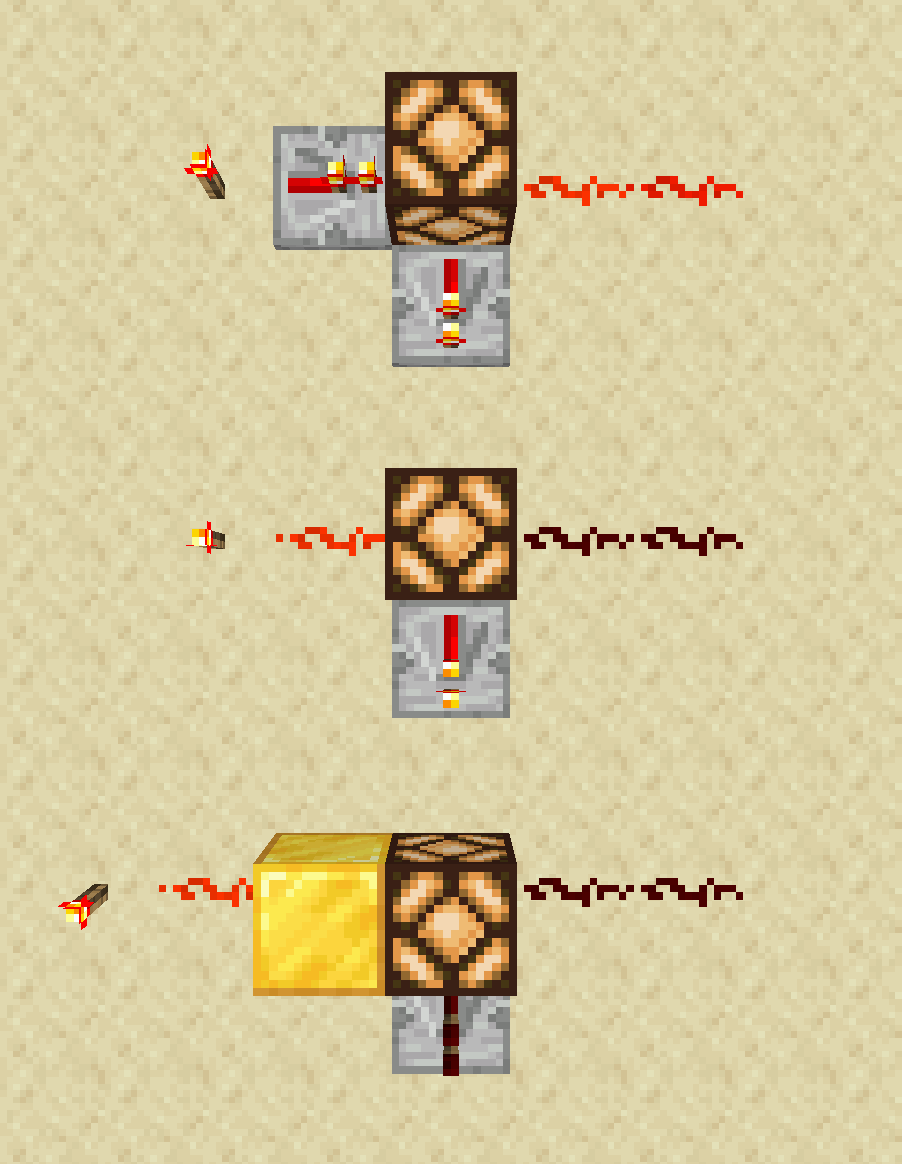
- Strongly powered: powers both Repeater and Dust.
- Weakly powered: powers Repeater, but not Dust.
- Not powered: powers neither.
Opaque blocks obstruct light and vision (with some exceptions: for example, glowstone is not considered an opaque block).
Opaque blocks are used to support redstone components and to transmit power.
- Strongly powered vs. weakly powered
- An opaque block is strongly powered by an active power component (except a block of redstone or a daylight detector), an active redstone repeater, or an active redstone comparator.
- An opaque block is weakly powered only by powered redstone dust on top of it, or pointing to it.
- Effect
- A powered opaque block turns OFF any attached redstone torch, turns ON any adjacent redstone repeater or redstone comparator facing away from it, and activates any adjacent mechanism component.
- A strongly-powered opaque block turns ON any adjacent redstone dust, including redstone dust beneath or on top of the opaque block; but a weakly-powered opaque block does not.
Use of transparent blocks
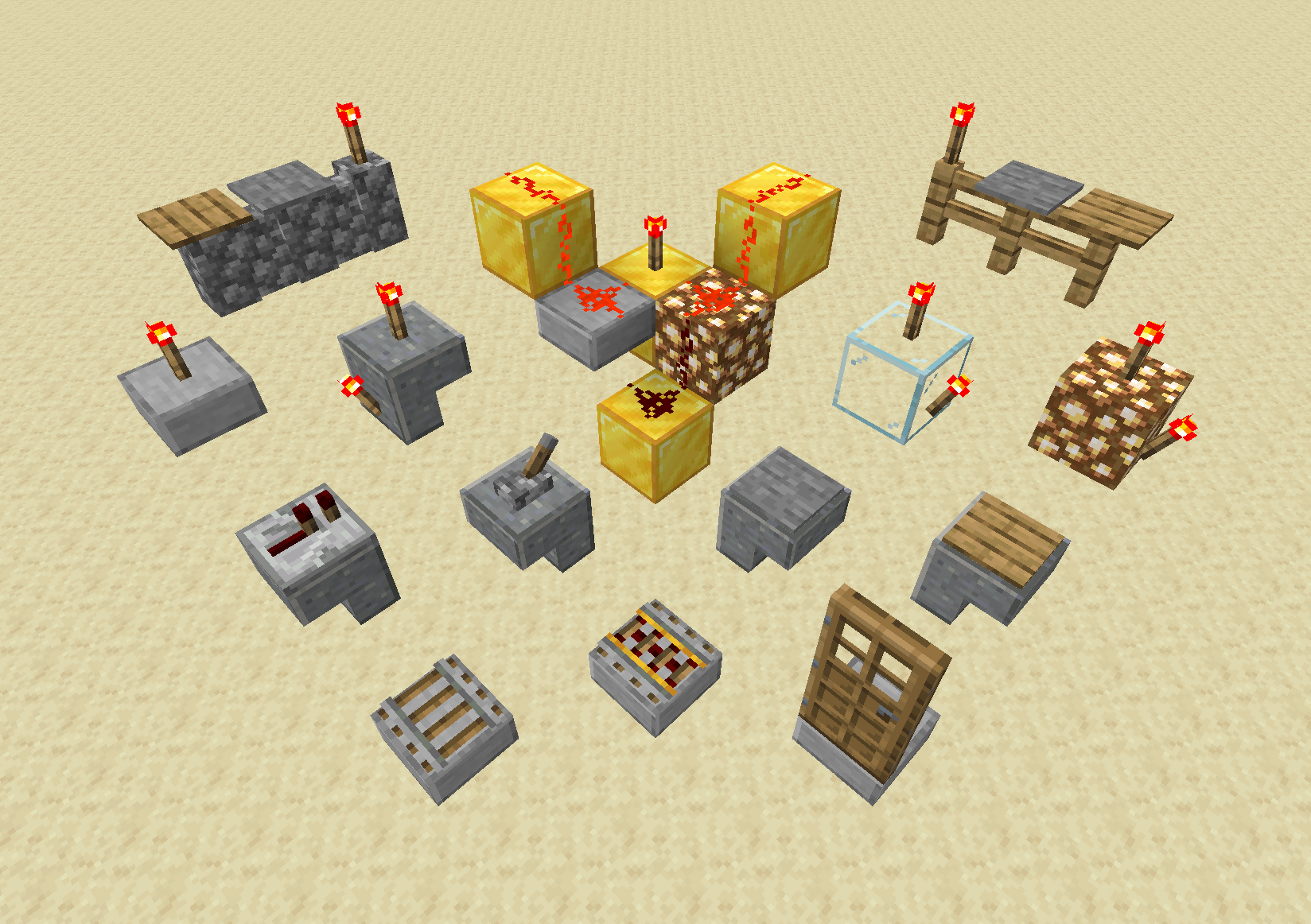
Transparent blocks either can be seen through fully (for example, glass) or partially (for example, stairs), or allow light to pass through (for example, leaves).
Transparent blocks cannot be powered, but can be used as insulators in compact circuits. Some transparent blocks have special properties that make them useful in redstone circuits:
- Fences
- Main article: Fence
- A redstone torch or a pressure plate can be attached to the top of a fence or nether brick fence.
- Glass
- Main article: Glass
- Glass behaves as an opaque block as it does not effect how redstone components can be placed on it.
- Glowstone
- Main article: Glowstone
- Glowstone behaves as an opaque block as it does not effect how redstone components can be placed on it.
- Redstone dust on top of glowstone cannot transmit power diagonally downward to other redstone dust. Because glowstone is not opaque, it cannot power an adjacent block (including an attached trapdoor), but redstone dust on top of it can.
- Slabs and Stairs
- Any redstone component that can be attached or placed on an opaque block can also be attached or placed on an upside-down slab or upside-down stairs.
- Redstone dust on top of an upside-down slab or upside-down stairs cannot transmit power diagonally downward to other redstone dust. Because slabs and stairs are not opaque, they cannot be powered by power components and cannot provide power to adjacent blocks.
- Walls
- Main article: Wall
- A redstone torch can be attached to the top of a wall. Walls change states when a block is moved to or away from a wall, and this output can be detected using observers.